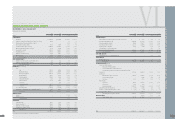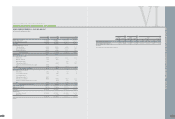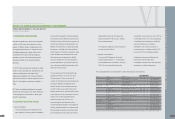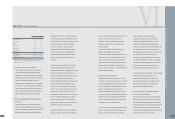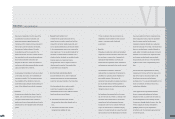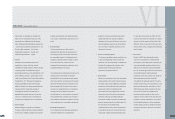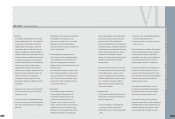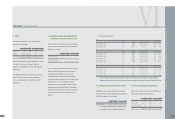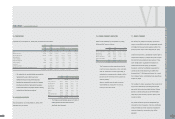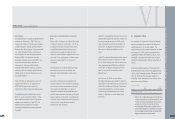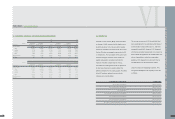HTC 2007 Annual Report Download - page 88
Download and view the complete annual report
Please find page 88 of the 2007 HTC annual report below. You can navigate through the pages in the report by either clicking on the pages listed below, or by using the keyword search tool below to find specific information within the annual report.
AN OVERVIEW OFTHE COMPANY'S FINANCIAL STATUS
171170
When treasury stocks are sold and the selling
price is above the book value, the difference
should be credited to the capital surplus -
treasury stock transactions. If the selling price is
below the book value, the difference should first
be offset against capital surplus from the same
class of treasury stock transactions, and any
remainder should be debited to retained
earnings. The carrying value of treasury stocks
should be calculated using the weighted-
average method.
When the Company's treasury stock is retired,
the treasury stock account should be credited,
and the capital surplus - premium on stock
account and capital stock account should be
debited proportionately according to the share
ratio. The difference should be credited to
capital surplus or debited to capital surplus
and/or retained earnings.
>
F
or
e
i
gn Curr
e
n
c
i
e
s
The financial statements of foreign operations
are translated into New Taiwan dollars at the
following exchange rates:
a. Assets and liabilities - at exchange rates
prevailing on the balance sheet date;
b. Stockholders' equity - at historical exchange
rates;
c. Dividends - at the exchange rate prevailing on
the dividend declaration date; and
d. Income and expenses - at average exchange
rates for the year.
Exchange differences arising from the translation
of the financial statements of foreign operations
are recognized as a separate component of
stockholders' equity. Such exchange differences
are recognized as gain or loss in the year in
which the foreign operations are disposed of.
Nonderivative foreign-currency transactions are
recorded in New Taiwan dollars at the rates of
exchange in effect when the transactions occur.
Exchange differences arising from the settlement
of foreign-currency assets and liabilities are
recognized as gain or loss.
At the balance sheet date, foreign-currency
monetary assets and liabilities are revalued at
prevailing exchange rates, and the exchange
differences are recognized as gain or loss.
At the balance sheet date, foreign-currency
nonmonetary assets (such as equity instruments)
and liabilities that are measured at fair value are
revalued at prevailing exchange rates, with the
exchange differences recognized as follows:
VI
> In
c
om
e
T
a
x
The Company adopted Statement of Financial
Accounting Standards No. 22 - "Accounting for
Income Taxes," which requires an asset and
liability approach to financial accounting and
reporting for income tax. Deferred income tax
assets and liabilities are computed annually for
differences between the financial statement and
tax bases of assets and liabilities that will result
in taxable or deductible amounts in the future
based on enacted tax laws and rates applicable
to the periods in which the differences are
expected to affect taxable income. Valuation
allowances are provided for deferred tax assets
that are not certain to be realized. Income tax
expense or benefit is the tax payable or
refundable for the period plus or minus the
change during the period in deferred tax assets
and liabilities.
Adjustment of prior years' income tax is added
to current income tax expense in the year the
adjustment is made.
Income tax of 10% on unappropriated earnings
is expensed in the year of stockholder approval,
which is the year right after the year of earnings
generation.
All subsidiaries file income tax returns based on
the regulations of their respective local
governments. In addition, there is no material
difference in the accounting principles on
income taxes between the parent company and
those of its subsidiaries.
> S
t
o
ck
-B
a
s
e
d Emp
l
oy
ee
Comp
e
ns
a
t
i
on P
l
a
ns
When the grant date of stock-based employee
compensation plans is on or after January 1,
2004, the Company applies the accounting
guidelines for stock-based compensation issued
by the Accounting
Research and Development Foundation of the
ROC. Under these guidelines, the fair value of
option compensation is recorded initially as an
asset. This asset is expensed ratably over the
service period, which is generally the period
over which the options vest.
> Tr
ea
sury S
t
o
ck
The Company adopted the Statement of
Financial Accounting Standards No. 30 -
"Accounting for Treasury Stocks," which
requires the treasury stock held by the
Company to be accounted for by the cost
method. The cost of treasury stock is shown as
a deduction to arrive at stockholders' equity,
while gain or loss from selling treasury stock is
treated as an adjustment to capital surplus.
FINANCEI CONSOLIDATED REPORT
l



